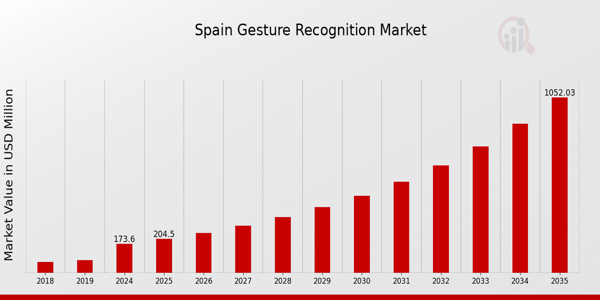Spain Gesture Recognition Market Overview
As per MRFR analysis, the Spain Gesture Recognition Market Size was estimated at 146.8 (USD Million) in 2023.The Spain Gesture Recognition Market Industry is expected to grow from 173.6(USD Million) in 2024 to 1,052 (USD Million) by 2035. The Spain Gesture Recognition Market CAGR (growth rate) is expected to be around 17.797% during the forecast period (2025 - 2035).
Key Spain Gesture Recognition Market Trends Highlighted
The Spain Gesture Recognition Market is influenced by several key market drivers, primarily stemming from rising consumer demand for hands-free interaction technologies across various sectors, including consumer electronics, healthcare, and automotive. The growth of mobile devices and the adoption of smart home technologies in Spain are contributing significantly to the momentum in this market. Spanish companies like Universidad Politécnica de Madrid are innovating in gesture recognition solutions, indicating strong local support for research and development in this space. Furthermore, the increasing integration of artificial intelligence and machine learning in gesture recognition systems has been observed, enhancing accuracy and user experience.
Opportunities to be explored include collaborations between tech companies and local startups focusing on gesture-based interactions. This could lead to the development of specialized applications tailored to Spanish-speakers, ensuring that the technology adapts to unique cultural nuances and user preferences in Spain.
Additionally, the growing trend of utilizing gesture recognition in public safety and retail environments is emerging, providing a pathway for businesses to innovate customer interactions and enhance the overall shopping experience. Moreover, recent trends in Spain reflect a shift towards implementing gesture recognition in various industries, such as healthcare, where it can facilitate intuitive interactions in telehealth platforms.
The impact of the COVID-19 pandemic has accelerated the need for contactless solutions, notably in public spaces and institutions. Thus, the gesture recognition sector is witnessing a wave of transformation as businesses adapt to these changing consumer needs. Overall, Spain appears to be on a trajectory towards embracing gesture recognition technology, which aligns with broader global technological advancements while catering to local characteristics and demands.

Source: Primary Research, Secondary Research, MRFR Database and Analyst Review
Spain Gesture Recognition Market Drivers
Growing Adoption of Gesture Recognition Technology in Consumer Electronics
The use of gesture recognition technology in consumer electronics is growing significantly in the Spain Gesture Recognition Market Industry. Given that Spain is one of Europe's biggest markets for electronics, there has been a noticeable increase in the usage of wearable technology, gaming consoles, and smart TVs. The Spanish National Commission of Markets and Competition reports that advances in touchless interface technology and artificial intelligence contributed to a 15% increase in consumer electronics sales last year.
Leading organizations such as Samsung and Sony are already integrating gesture control features into their products, catering to consumers' demands for intuitive and immersive user experiences. This shift towards gesture-based controls is expected to boost market growth considerably as consumer preferences evolve.
Increase in Demand for Touchless Solutions Amidst Health Concerns
The ongoing health concerns due to various global pandemics have heightened the demand for touchless solutions across multiple sectors in Spain. Initiatives from the Spanish Government emphasize the importance of minimizing physical contact in public areas and workplaces, enhancing the need for gesture recognition technologies. According to a government report, there has been a 20% increase in investment towards touchless technology in the last two years, particularly in public service sectors such as transport and healthcare.
Organizations like Siemens and IBM have also been collaborating with government agencies to integrate gesture recognition systems in public spaces and healthcare facilities, highlighting its potential in improving safety and hygiene.
Advancements in Artificial Intelligence Driving Market Growth
The growth of the Spain Gesture Recognition Market Industry is substantially driven by advancements in artificial intelligence (AI), which enhance gesture recognition capabilities. AI technologies are increasingly utilized in enhancing the accuracy and efficiency of gesture recognition systems, making them more reliable and appealing for industries such as automotive, gaming, and healthcare.
The Spanish Government's push for innovation, backed by the 'Strategy for the Digitalization of Industry in Spain', has led to a notable increase in AI startups focusing on gesture recognition applications, with over 200 new businesses founded in the past year alone.Companies like Telefonica are investing heavily in AI Research and Development, fostering collaborations with educational institutions to create cutting-edge gesture recognition solutions that meet market demands.
Spain Gesture Recognition Market Segment Insights
Gesture Recognition Market Technology Insights
The Spain Gesture Recognition Market, particularly focusing on the Technology segment, has witnessed significant advancements and evolution over the years, driven largely by the increasing integration of smart devices and the growing adoption of interactive and immersive technologies across various applications. This market is characterized by its various components, notably the Sensor, 2D Gesture Technology, and 3D Gesture Technology categories, each playing a pivotal role in shaping the overall landscape. Sensors are fundamental in capturing and translating physical movements into digital signals, offering a crucial backbone for gesture recognition systems. Various types of sensors contribute to efficiently interpreting gestures, enhancing user experience across settings such as gaming, virtual reality, and smart home applications.
On the other hand, 2D Gesture Technology holds substantial importance, primarily in applications that require a more straightforward interaction model. Its ability to recognize flat plane gestures simplifies the user interface, making this technology prevalent in mobile devices and touchless control applications. 2D Gesture Technology appeals to users for its intuitive and seamless interaction capabilities, thus promoting adoption across diverse sectors such as retail and hospitality, where user engagement is critical. Meanwhile, 3D Gesture Technology emerges as a transformative force, offering the ability to recognize gestures in three-dimensional space, thereby enabling more complex and engaging user interactions. It plays a significant role in industries such as gaming and healthcare, where enhancing user experience through natural interactions is key. The demand for immersive experiences has driven innovations in this area, addressing needs for more interactive simulations and environments.
In summary, the Technology segment within the Spain Gesture Recognition Market illustrates a dynamic interplay between these components, each contributing uniquely to market growth. As the technology matures, the capabilities and applications of these technologies are expected to expand significantly, supported by ongoing Research and Development efforts aimed at improving gesture accuracy and responsiveness.
Emerging trends indicate that the integration of artificial intelligence and machine learning will further elevate the performance and application areas of gesture recognition technologies, making them pivotal tools in the user experience across multiple sectors in Spain. Market growth is underpinned by multiple factors, including consumer demand for advanced interaction methods and the influence of digital transformation initiatives across various industries, making the Spain Gesture Recognition Market a compelling area of observation for stakeholders looking to capitalize on the emerging opportunities.

Source: Primary Research, Secondary Research, MRFR Database and Analyst Review
Gesture Recognition Market Application Insights
The Spain Gesture Recognition Market exhibits significant potential across various applications, reflecting the growing integration of innovative technology into everyday life. The automotive sector is witnessing a surge in demand for gesture recognition systems to enhance user interaction and improve safety features. Similarly, the healthcare industry is incorporating gesture-based controls to facilitate hands-free operation of medical devices, thereby ensuring hygiene and efficiency. Consumer electronics remain a prominent area, with smart devices increasingly adopting gesture recognition for enhanced user experiences.
In the transportation sector, gesture technology is being utilized for navigation and user interface improvements, contributing to the overall enhancement of operational efficiency. Commercial applications also demonstrate a rising trend as businesses leverage gesture recognition for interactive displays and customer engagement, thereby driving sales and enhancing customer experiences. The IT/Telecom sector sees gesture recognition solutions being implemented for better accessibility and user-friendly interactions in software and applications.
As these sectors continue to mature, the Spain Gesture Recognition Market segmentation across these applications indicates a growing inclination towards technological advancements, underscoring the importance of innovation in shaping user experiences and operational efficiencies.
Gesture Recognition Market Product Insights
The Spain Gesture Recognition Market within the Product segment is witnessing considerable interest, driven by technological advancements and the demand for innovative interaction methods. Touchless solutions, which allow users to interact without physical contact, are gaining traction due to heightened hygiene awareness and convenience. Meanwhile, Touch-Based solutions continue to thrive, catering to environments where tactile feedback enhances usability and user experience. The increasing incorporation of gesture recognition technology across various sectors such as automotive, gaming, and healthcare is a key growth driver for the market.
Additionally, Spain's commitment to digital transformation, as outlined in its national strategies, is likely to bolster the adoption of gesture recognition technologies. The combination of both touchless and touch-based solutions is essential for meeting diverse user preferences, making the Spain Gesture Recognition Market segmentation vital for tailored products and services. As the market evolves, these segments are expected to adapt and innovate, addressing challenges like privacy concerns and enhancing user interface designs, which will ultimately foster further growth and engagement in the industry.
Spain Gesture Recognition Market Key Players and Competitive Insights
The Spain Gesture Recognition Market has been experiencing significant growth due to the increasing demand for touchless technology across various sectors, including entertainment, automotive, and healthcare. As companies strive to integrate advanced technology into their products and services, the competitive landscape has been shaped by several key players who are focusing on innovation and differentiation. This market is characterized by a mix of established players and emerging startups, all striving to capture a share of the growing demand for gesture-based interfaces and related solutions. The rise of smart devices, along with advancements in artificial intelligence and computer vision, has created numerous opportunities for companies to develop and enhance their gesture recognition technologies, allowing for a deeper analysis of competitive strategies and market dynamics.
In Spain, 3D Motion has established a noteworthy presence in the gesture recognition market, primarily due to its innovative approach to motion capture technology, which enables accurate and responsive gesture recognition. The company's strength lies in its ability to offer high precision and customizable solutions for various applications, including gaming and virtual reality. Their technology leverages sophisticated algorithms and sensors to ensure real-time tracking and interpretation of user movements, making it a preferred choice for developers and corporate clients looking to implement gesture recognition in their offerings. This capacity to blend cutting-edge technology with consumer needs has positioned 3D Motion as a formidable competitor in the Spanish market, allowing it to establish strategic partnerships and collaborations that reinforce its market presence.
Google has also made inroads into the Spain Gesture Recognition Market by leveraging its robust technological expertise and research capabilities to develop advanced gesture recognition solutions. The company has introduced products that integrate gesture-based controls into smart home devices, mobile applications, and gaming platforms, enhancing user experience and interactivity.
Google’s strengths include its vast data analytics capabilities and development of machine learning algorithms, which improve gesture recognition accuracy and reliability. Furthermore, Google has strategically engaged in partnerships and potential acquisitions to bolster its technological portfolio and expand its reach within Spain. This approach not only enhances its market presence but also positions Google favorably amongst competitors by continuously innovating its services and adapting to the evolving needs of the Spanish consumer market. The combination of these factors underpins Google's competitive positioning within the gesture recognition sector in Spain, allowing it to maintain a leading role in this promising market.
Key Companies in the Spain Gesture Recognition Market Include:
- 3D Motion
- Google
- Apple
- Euronews
- GestureTek
- Samsung
- Nuance Communications
- IBM
- Intel
- Amazon
- Sony
- Qualcomm
- Microsoft
- Leap Motion
- Coincident
Spain Gesture Recognition Market Industry Developments
The Spain Gesture Recognition Market has seen significant developments recently, particularly with the rise of smart technologies and artificial intelligence applications. Notable progress has been made with companies like Sony and Microsoft enhancing their gesture recognition capabilities in consumer electronics. In September 2023, Samsung announced a partnership focused on integrating advanced gesture recognition in smart home devices, further capitalizing on consumer demand for intuitive interfaces.
Current affairs indicate an increasing investment in Research and Development by major players such as Google and Apple to refine gesture recognition technologies for applications in augmented reality. In terms of mergers, Leap Motion acquired Coincident in August 2023 to bolster its hardware solutions in Spain’s market.
Furthermore, the growth of the Spain Gesture Recognition Market is remarkable, reflecting a boost in market valuation primarily driven by heightened applications in the gaming and healthcare sectors. In recent years, especially since early 2022, there has been a growing interest in implementing gesture recognition systems across various industries within Spain, especially in enhancing user experiences and accessibility, showcasing the market's robust expansion opportunities.
Spain Gesture Recognition Market Segmentation Insights
Gesture Recognition Market Technology Outlook
-
- Sensor
- 2D Gesture Technology
- 3D Gesture Technology
Gesture Recognition Market Application Outlook
-
- Automotive
- Healthcare
- Consumer Electronics
- Transportation
- Commercial
- IT/Telecom
Gesture Recognition Market Product Outlook
| Report Attribute/Metric Source: |
Details |
| MARKET SIZE 2023 |
146.8(USD Million) |
| MARKET SIZE 2024 |
173.6(USD Million) |
| MARKET SIZE 2035 |
1052.0(USD Million) |
| COMPOUND ANNUAL GROWTH RATE (CAGR) |
17.797% (2025 - 2035) |
| REPORT COVERAGE |
Revenue Forecast, Competitive Landscape, Growth Factors, and Trends |
| BASE YEAR |
2024 |
| MARKET FORECAST PERIOD |
2025 - 2035 |
| HISTORICAL DATA |
2019 - 2024 |
| MARKET FORECAST UNITS |
USD Million |
| KEY COMPANIES PROFILED |
3D Motion, Google, Apple, Euronews, GestureTek, Samsung, Nuance Communications, IBM, Intel, Amazon, Sony, Qualcomm, Microsoft, Leap Motion, Coincident |
| SEGMENTS COVERED |
Technology, Application, Product |
| KEY MARKET OPPORTUNITIES |
Increasing demand in gaming industry, Growth in automotive applications, Adoption in smart home devices, Advancements in healthcare technologies, Expansion in retail experiences |
| KEY MARKET DYNAMICS |
Technological advancements, Increasing consumer demand, Rising adoption in gaming, Growth in smart devices, Integration with AI technologies |
| COUNTRIES COVERED |
Spain |
Frequently Asked Questions (FAQ):
By 2024, the Spain Gesture Recognition Market is expected to be valued at approximately 173.6 million USD.
The market is projected to reach around 1052.0 million USD by 2035.
The CAGR for the Spain Gesture Recognition Market is expected to be 17.797% from 2025 to 2035.
In 2024, the Sensor technology segment is valued at approximately 40.0 million USD.
The 2D Gesture Technology segment is projected to reach about 300.0 million USD by 2035.
Major players in the market include Google, Apple, Samsung, IBM, Microsoft, and Amazon.
The 3D Gesture Technology segment is expected to be valued at approximately 83.6 million USD in 2024.
The market presents opportunities in diverse applications such as gaming, healthcare, and automotive sectors.
Key challenges include rapid technological advancements and the need for substantial investment in R&D.
By 2035, the Sensor technology segment is expected to grow to approximately 240.0 million USD.
















